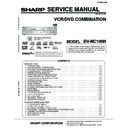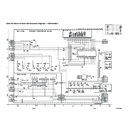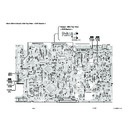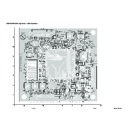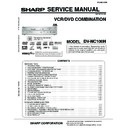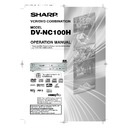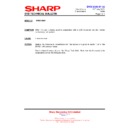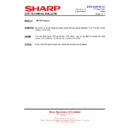Sharp DV-NC100H (serv.man6) Service Manual ▷ View online
2-2-1
H9740FIX
SERVICE FIXTURE AND TOOLS
J-1-1, J-1-2, J-1-3, J-1-4, J-1-5
J-2
J-3
J-4
J-5
J-1-1
J-1-2
J-2
9HSFL6A
9HSFL6NS8
---
---
---
---
J-3
J-4
J-5
BX
Head Adjustment of ACE Head
BX
BX
J-1-3
Test Tape
Ref.
No.
Name
Parts No.
Code
Adjustment
Test Tape
Guide Roller Adj.
Screwdriver
Screwdriver
Mirror
Azimuth Adj.
Screwdriver +
Screwdriver +
Flat Screwdriver
Test Tape
9HSFL6HA
Available Locally
Available Locally
Available Locally
Available Locally
Azimuth and X Value Adjustment of ACE Head /
Adjustment of Envelope Waveform
Adjustment of Envelope Waveform
For Measurement of Hi-Fi Output Level
BX
J-1-4 Test Tape
9HSFL6M
For Measurement of Resolution
BX
J-1-5 Test Tape
9HSFL6K
For Measurement of Audio Frequency Response
Guide Roller
ACE Head Height
Tape Transportation Check
X Value
2-3-1
H9740MA
Explanation of alignment for the tape to correctly run
starts on the next page. Refer to the information below on
this page if a tape gets stuck, for example, in the
mechanism due to some electrical trouble of the unit.
starts on the next page. Refer to the information below on
this page if a tape gets stuck, for example, in the
mechanism due to some electrical trouble of the unit.
Service Information
A. Method for Manual Tape Loading/Unloading
To load a cassette tape manually:
1. Disconnect the AC plug.
2. Remove the Top Case and Front Assembly.
3. Insert a cassette tape. Though the tape will not be
automatically loaded, make sure that the cassette
tape is all the way in at the inlet of the Cassette Holder.
To confirm this, lightly push the cassette tape further
in and see if the tape comes back out, by a spring
motion, just as much as you have pushed in.
tape is all the way in at the inlet of the Cassette Holder.
To confirm this, lightly push the cassette tape further
in and see if the tape comes back out, by a spring
motion, just as much as you have pushed in.
4. Turn the LDG Belt in the appropriate direction shown
in Fig. M1 for a minute or two to complete this task.
To unload a cassette tape manually:
1. Disconnect the AC plug.
2. Remove the Top Case and Front Assembly.
3. Make sure that the Moving guide preparations are in
the Eject Position.
4. Turn the LDG Belt in the appropriate direction shown
in Fig. M1 until the Moving guide preparations come
to the Eject Position. Stop turning when the prepara-
tions begin clicking or can not be moved further.
However, the tape will be left wound around the
cylinder.
to the Eject Position. Stop turning when the prepara-
tions begin clicking or can not be moved further.
However, the tape will be left wound around the
cylinder.
5. Turn the LDG Belt in the appropriate direction con-
tinuously, and the cassette tape will be ejected. Allow
a minute or two to complete this task.
a minute or two to complete this task.
MECHANICAL ALIGNMENT PROCEDURES
B. Method to place the Cassette Holder in the tape-
loaded position without a cassette tape
1. Disconnect the AC Plug.
2. Remove the Top Case and Front Assembly.
3. Turn the LDG Belt in the appropriate direction shown
in Fig. M1. Release the locking tabs shown in Fig. M1
and continue turning the LDG Belt until the Cassette
Holder comes to the tape-loaded position. Allow a
minute or two to complete this task.
and continue turning the LDG Belt until the Cassette
Holder comes to the tape-loaded position. Allow a
minute or two to complete this task.
Moving guide T preparation
(Eject Position)
(Eject Position)
LDG Belt
Push the locking tab gently to unlock
when loading without a cassette.
when loading without a cassette.
Side View
Moving guide S preparation
(Eject Position)
(Eject Position)
Push the tape
to load it.
to load it.
UNLOAD
/EJECT
/EJECT
LOAD
Fig. M1
Top View
Fig. M2
Bottom View
Cam Gear
LDG Belt (B)
UNLOAD
/EJECT
/EJECT
2-3-2
H9740MA
1. Tape Interchangeability Alignment
Note:
To do these alignment procedures, make sure that the Tracking Control Circuit is set to the preset position every time
a tape is loaded or unloaded. (Refer to page 2-3-4, procedure 1-C, step 2.)
a tape is loaded or unloaded. (Refer to page 2-3-4, procedure 1-C, step 2.)
Equipment required:
Dual Trace Oscilloscope
VHS Test Tape (9HSFL6NS8) (Refer to "SERVICE FIXTURE AND TOOLS" section.)
Guide Roller Adj. Screwdriver
Flat Screwdriver (Purchase Locally)
Note: Before starting this Mechanical Alignment, do all Electrical Adjustment procedures.
Adjust the X Value for maximum envelope.
(Page 2-3-3) (Use Alignment Tape.)
(Page 2-3-3) (Use Alignment Tape.)
Check to see that the tape is not creasing
and that there is no slack on the supply
and take-up side Guide Rollers.
(Use a blank tape.)
and that there is no slack on the supply
and take-up side Guide Rollers.
(Use a blank tape.)
Adjust the height of the Guide Rollers
(Supply side and take-up side).
(Use a blank tape.) (Page 2-3-3)
(Supply side and take-up side).
(Use a blank tape.) (Page 2-3-3)
Loading (Use a blank tape.)
Adjust the envelope. (Page 2-3-4)
Check the envelope.
Adjust the Audio Section.
(Azimuth Alignment) (Page 2-3-4)
(Azimuth Alignment) (Page 2-3-4)
Check the audio output.
Check the following:
1. X Value (Page 2-3-3)
2. Envelope (Page 2-3-4)
1. X Value (Page 2-3-3)
2. Envelope (Page 2-3-4)
Adjust the X value and envelope.
No good
Completion
No good
OK
OK
OK
No good
No good
OK
Flowchart of Alignment for tape traveling
1-A
1-A
1-B
1-C
1-C
1-D
1-D
1-B, 1-C
1-B, 1-C
Do the final tape-traveling test to see that
the tape runs normally in play mode with-
out creasing or slacking.
the tape runs normally in play mode with-
out creasing or slacking.
OK
Check to see that the tape is not creasing
and that there is no slack on the REV Post.
(Use a blank tape.)
and that there is no slack on the REV Post.
(Use a blank tape.)
1-E
1-A
2-3-3
H9740MA
1-A. Preliminary/Final Checking and
Alignment of Tape Path
Purpose:
To make sure that the tape path is well stabilized.
Symptom of Misalignment:
If the tape path is unstable, the tape will be damaged.
Note: Do not use an Test Tape for this procedure. If the
unit is not correctly aligned, the tape may be damaged.
unit is not correctly aligned, the tape may be damaged.
1. Playback a blank cassette tape and check to see that
the tape runs without creasing at Guide Rollers [2]
and [3], and at points A and B on the lead surface.
(Refer to Fig. M3 and M4.)
and [3], and at points A and B on the lead surface.
(Refer to Fig. M3 and M4.)
2. If creasing is apparent, align the height of the guide
rollers by turning the top of Guide Rollers [2] and [3]
with a Guide Roller Adj. Screwdriver. (Refer to Fig.
M3 and M5.)
with a Guide Roller Adj. Screwdriver. (Refer to Fig.
M3 and M5.)
Guide Roller [2]
Guide Roller [3]
A
B
Take-up Guide Post [4]
ACE Head
Fig. M3
Lead Surface of Cylinder
Tape
Fig. M4
Take-up Guide
Post
Post
Tape
Guide Roller
Tape
Correct
Incorrect
Fig. M5
3. Check to see that the tape runs without creasing at
Take-up Guide Post [4] or without snaking between
Guide Roller [3] and ACE Head. (Fig. M3 and M5)
Guide Roller [3] and ACE Head. (Fig. M3 and M5)
4. If creasing or snaking is apparent, adjust the Tilt Adj.
Screw of the ACE Head. (Fig. M6)
Azimuth Adj. Screw
Flat
Screwdriver
Screwdriver
Tilt Adj. Screw
ACE Head
Fig. M6
1-B. X Value Alignment
Purpose:
To obtain maximum PB FM envelope signal at the preset
position of the Tracking Control Circuit, align the Horizontal
Position of the ACE Head.
position of the Tracking Control Circuit, align the Horizontal
Position of the ACE Head.
Symptom of Misalignment:
If the Horizontal Position of the ACE Head is not properly
aligned, maximum PB FM envelope cannot be obtained
at the preset position of the Tracking Control Circuit.
aligned, maximum PB FM envelope cannot be obtained
at the preset position of the Tracking Control Circuit.
1. Connect the oscilloscope to TP301 (C-PB) and TP503
(CTL) on the Main CBA. Use TP504 (RF-SW) as a
trigger.
trigger.
2. Playback the Gray Scale of the Test Tape
(9HSFL6NS8) and confirm that the PB FM signal is
present.
present.
3. Set the Tracking Control Circuit to the preset position
by pressing CH UP button on the remote control unit
then "PLAY" button on the unit. (Refer to note on
bottom of page 2-3-4.)
then "PLAY" button on the unit. (Refer to note on
bottom of page 2-3-4.)
4. Use the Flat Screwdriver so that the PB FM signal at
TP301 (C-PB) is maximum. (Fig. M6)
5. To shift the CTL waveform, press CH UP or CH
DOWN button on the remote control unit. Then make
sure that the maximum output position of PB FM
envelope signal become within
sure that the maximum output position of PB FM
envelope signal become within
±
2ms from preset
position.


